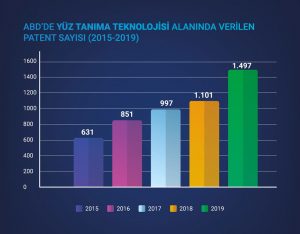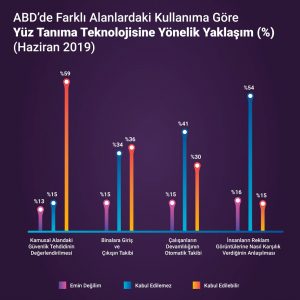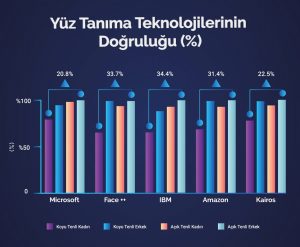AMERICANS ARE BEING MONITORED
The portrayal of facial recognition technology as a tool exclusive to authoritarian regimes is a misconception. In reality, the situation in the U.S. is quite different. This article reveals how Americans are being surveilled through official institutions and U.S.-based companies.
Facial recognition is a technology based on machine learning, a component of artificial intelligence, which allows for the identification of individuals through photos, videos, or in real-time.
The global market for facial recognition technology, valued at $3.8 billion in 2020, is expected to grow to $8.5 billion by 2025. This growth is anticipated to be driven primarily by the government and defense sectors, although the technology is also utilized by civilian entities.
Are There Limits to the Technology?
According to Kairos, a U.S.-based facial recognition company that serves the civilian sector, simply recognizing faces is not enough. The next step is demographic and emotional analysis of the faces in the images. Kairos’ technology enables clients to access data such as a person’s age, gender, emotion, time spent in a store, and whether they have visited before.
In 2018, the American Civil Liberties Union (ACLU) inquired whether companies like Disney, Wal-Mart Stores, and McDonald’s were using facial recognition technology on their customers. Out of 20 companies, only one confirmed it wasn’t using the technology, while another admitted to using it but not for identifying customers. The remaining 18 companies refused to respond, indicating that facial recognition technology cannot simply be reduced to a security mission; it is also used to enhance customer satisfaction and economic output.
The integration of facial recognition technology into smartphones, not just as a method to unlock screens but also as a feature in mobile applications, is one of the significant trends in this field.
Figure 1

Source: GAO, “Facial Recognition Technology: Privacy and Accuracy Issues Related to Commercial Uses,” https://www.gao.gov/assets/710/708045.pdf (Accessed: 05.02.2021), p.9. As indicated in Figure 1, the number of patents granted in the U.S. for facial recognition technologies has steadily increased from 2015 to 2019.
Figure 2

Source: eMarketer, “Consumers Warm Up to Facial Recognition to Keep Them Safe, but for Marketing and Advertising, No Thanks,” https://www.emarketer.com/content/consumers-warm-to-facial-recognition-to-keep-them-safe-but-for-marketing-and-advertising-no-thanks (Accessed: 04.02.2021).As seen in Figure 2, the differences in usage areas affect the perceived acceptability of facial recognition technology among Americans.
Although the survey results in Figure 2 suggest that the use of facial recognition technology for public safety is relatively acceptable to Americans, the U.S.’s long-standing issue with racism leads to concerns about all potential outcomes of the technology. In this context, the use and development of facial recognition technology in the U.S. are primarily debated from a racial standpoint. One of the major discussion points is how the capabilities of facial recognition technology differ based on gender and race.
Figure 3

Source: Alex Najibi, “Racial Discrimination in Face Recognition Technology,” http://sitn.hms.harvard.edu/flash/2020/racial-discrimination-in-face-recognition-technology/ (Accessed: 04.02.2021). As shown in Figure 3, different companies’ facial recognition technologies have achieved a high level of accuracy in identifying fair-skinned males. However, these technologies have been inadequate in recognizing dark-skinned females.
Facial Recognition Technology as a Tool for Domestic Security
Although facial recognition technology is often associated with authoritarian countries like China, it has long been a component of ensuring domestic security in the U.S. For instance, the New York City Police Department has used facial recognition technology since 2011 to identify suspects captured on camera for various crimes.
The death of African American George Floyd in May 2020, while being detained by the police, sparked accusations of racism against the U.S. police and increased pressure to limit the high-tech tools available to law enforcement.
In June 2020, IBM CEO Arvind Krishna sent a letter to Congress, citing the tragic deaths of George Floyd, Ahmaud Arbery, Breonna Taylor, and others. He emphasized that while technology can help the police protect communities, it should not support discrimination and racial injustice. Consequently, IBM decided not to offer general-purpose facial recognition or analysis software. Krishna also stated that IBM would not tolerate the use of any technology, including facial recognition offered by other vendors, for mass surveillance, racial profiling, or violations of basic human rights and freedoms.
However, it has been reported that between 2012 and 2016, IBM obtained images of New Yorkers from the New York City Police Department to develop software that could identify individuals based on physical characteristics such as hair color, beards, and skin tones captured by security cameras.
Following IBM, Amazon decided to halt the sale of facial recognition technology to U.S. police for a year, and Microsoft chose not to offer it until legal regulations were established. In contrast, Clearview AI, a facial recognition start-up that can only be used by law enforcement personnel, continued its operations, drawing heavy criticism from Silicon Valley and Democrats.
A major concern among U.S. experts regarding facial recognition technology is the overrepresentation of non-whites in crime databases, which could lead to disproportionate arrests in a self-perpetuating cycle. This issue can be seen clearly in the New York City Police Department’s “gang database,” which includes information on individuals the police suspect of being or confirm as gang members. The criteria for inclusion in this database are unclear, and it is claimed that certain physical characteristics, such as specific tattoos, are sufficient for a person to be added to the database.
According to the New York City Police Department, as of 2019, nearly 500 of the 18,084 individuals in the database were minors. Furthermore, children as young as 13 were included. Beyond these official figures, Professor Babe Howell estimated that as of February 2018, 42,334 people were in the database. Additionally, between December 2013 and February 2018, approximately 66% of the new additions to the database were black, and 33% were Hispanic, while only 0.8% were white. However, 25% of the city’s population is black, and 27% is of Latin descent.
Unlike traditional facial recognition systems that rely on photos provided by the government, such as driver’s license and criminal records, Clearview AI’s database contains over 3 billion photos gathered from social media networks and other publicly accessible websites. According to its founder and CEO, Hoan Ton-That, Clearview AI is used by 2,400 law enforcement agencies in the U.S., including the FBI.
While IBM, Amazon, and Microsoft have taken a stand against the U.S. police, it can be argued that Clearview AI remains valuable for U.S. domestic security. Indeed, Hoan Ton-That stated that in January 2021, immediately after the storming of the Capitol, the use of Clearview AI increased by 26% compared to an average weekday.
What Happens Next?
In addition to the steps taken by individual companies, several states in the U.S. have made efforts to curb police use of facial recognition technology.
In 2020, Democrats proposed a bill to prevent federal agencies, including the FBI, from accessing facial recognition technology, but it failed to become law. Today, Democratic politicians say the bill will be reintroduced, but it is difficult to predict whether ethical values or the security mission will be prioritized under Democratic leadership.
Similarly, when those being surveilled are not Americans—when the technology is used by the military, for example—ethical values and concerns about facial recognition technology are often overlooked in discussions.
In the coming days, the choice between ethics and security, and between ethics and economic output, will likely influence various aspects of socio-economic life in the U.S.
